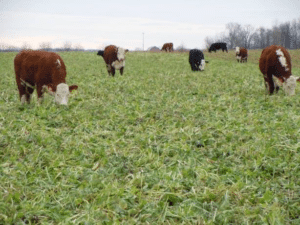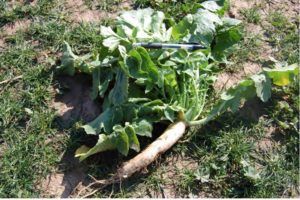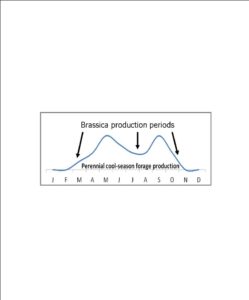Incorporating Forage Brassicas into a Grazing System
Planting brassicas in your pasture provides more than just high quality forage.
Dr. Leanne Dillard
Forage brassicas are annuals that can be utilized as pasture during the spring, summer,and fall grazing seasons. Forage brassicas include varieties of rapeseed (rape), radish, turnip,swede, kale, and hybrids. They are quick maturing and can be grazed 60 to 120 days after planting, depending on species. They are able to produce up to 4 tons of DM/acre, and varieties of turnip, radish, and swede produce a highly palatable and nutritious tap-root that can be grazed during the last rotation of the season.
Brassicas contain a high crude protein (CP) concentration (20 – 25%), net energy of metabolism [(NEM) 0.65 – 0.80 Mcal/lb] and total digestible nutrient (TDN) concentrations (65 –70%). In dairy cattle, a mixture of turnip and forage sorghum was shown to increase milk yield,milk solids, and protein in cattle during summer compared with sorghum alone; however, a reduction in milk fat was seen. Brassicas have also been reported to increase daily gain of beef cattle and sheep compared with other cool-season forages.
Besides being a high quality feed stuff, brassicas also have multiple environmental benefits. Tillage radish has been used for many years in no-till systems as a method to alleviate soil compaction. Brassicas are also useful in remediating soils high in phosphorus, by taking up P and incorporating it into their plant tissues. Furthermore, there is evidence that a plant metabolite in brassicas (glucosinolate) can reduce enteric methane emissions from ruminants consuming brassicas or brassica by-products (e.g., canola meal). This results in a decrease in the environmental impact of animals, and increase animal production efficiency.
Forage brassicas are most commonly grazed. They can also be stockpiled, ensiled, or fed as greenchop. Due to the low dry matter, haying is not an option. Successful grazing management can be accomplished through strip or rotational grazing. Once forage has reached~14”, animals can begin to graze. This can vary depending on species and variety used. If multiple grazings are desired, forage should not be grazed below a height of 6 – 8 inches. The root-bulb of turnip, radish, and swede can be grazed during the last grazing rotation of the season. If ensiled, a higher-dry matter forage should be included to ensure proper fermentation and reduce nutrient losses. The diets of livestock with high production/growth rates (e.g.lactating dairy cattle, stockers) can be fed up to 50% brassicas. In other classes of livestock (e.g.non-lactating dairy cattle, cow-calf pairs), brassicas should be treated as a supplemental feed due to the high energy content of the forage and grazing should be limited to only a few hours/day.
Brassicas are an acquired taste and an adaptation period may be required for some animals.
This can be achieved by giving access to low-quality hay, allowing access to perennial pastures, or planting brassicas as a mixture with other forages. Alternatively, animals experienced with brassicas can be used to train naïve animals to graze both the leaves and the root-bulb of plants. Brassicas are an excellent forage for cattle, sheep, goats, swine, and poultry. Equine species should not be fed brassicas due to concerns with toxicity. A trace mineral that includes Cu and I should be fed to livestock to prevent possible deficiencies and small ruminants tend to be more susceptible to these mineral deficiencies than cattle. SheepCu requirements are lower than that of other ruminants, thus Cu supplementation of sheep should be done with care, especially if co-grazing multiple species. Nitrate poisoning and bloat have been reported in ruminants consuming pure brassicas pastures. This can be avoided by planting brassicas in a mixture with other forage species or only allowing limited access to brassica pastures. Due to off-flavor, a withdrawal period of 4 hrs prior to milking and 7 days prior to slaughter is suggested; the withdrawal time will decrease as brassicas decrease as a percent of the total animal diet.

Tillage radishes provide high quality nutrition while alleviating soil compaction in no-till systems.
Our research group, using funds from the Northeast SARE program, is conducting laboratory and on-farm research to determine the establishment methods and methane reduction potential of several brassica varieties for use in pasture-based dairy farms throughout the Northeast. Currently, we are gathering information on the current use of brassicas in the forage programs of these farms. If you are currently a dairy producer and would be willing to share information regarding your current forage and grazing management with us, we would be appreciative if you would go to: https://www.surveymonkey.com/r/BWR3RDC to fill out an on-line survey or you can contact us directly at Leanne.Dillard@ars.usda.gov or 814-863-0947.
Dr. Leanne Dillard is a Research Animal Scientist at the USDA-ARS Pasture Systemsand Watershed Management Research Unit in University Park, PA. She can be reached at (814)863-0947 or Leanne.Dillard@ars.usdsa.gov.



